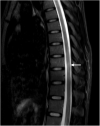Classical Triad and Periventricular Lesions Do Not Necessarily Indicate Wernicke's Encephalopathy: A Case Report and Review of the Literature
- PMID: 32587564
- PMCID: PMC7297919
- DOI: 10.3389/fneur.2020.00451
Classical Triad and Periventricular Lesions Do Not Necessarily Indicate Wernicke's Encephalopathy: A Case Report and Review of the Literature
Abstract
The classical triad-ophthalmoplegia, cerebellar dysfunction, and altered mental state-in addition to bilateral symmetrical periventricular lesions are actually common to see, and clinicians tend to associate that with Wernicke's encephalopathy (WE). The diagnosis is strengthened with a likely deficiency of thiamine. We herein describe a malnourished patient with clinical triad and hyperintensities in the circumventricular regions, and she turned out to have neuromyelitis optica spectrum disorder (NMOSD) after many twists and turns. Despite totally different pathogenic mechanisms, NMOSD can mimic WE, sometimes even exhibiting radiological features similar to that of WE, thereby complicating the diagnosis. Our case highlights how similar these two diseases could be and the importance of differential diagnosis in clinical practice, which are so far rarely reported. Some clinical and radiological differences of these two diseases are summarized to help establish a prompt diagnosis.
Keywords: Wernicke's encephalopathy; differential diagnosis; magnetic resonance imaging; neuromyelitis optica; periventricular lesions; triad.
Copyright © 2020 Ye, Xu, Deng and Yang.
Figures


Similar articles
-
Neuromyelitis Optica Spectrum Disorder Resembling Wernicke's Encephalopathy: A Case Report and Review of the Literature.Neurohospitalist. 2024 Apr;14(2):213-217. doi: 10.1177/19418744241228004. Epub 2024 Jan 16. Neurohospitalist. 2024. PMID: 38666289 Free PMC article.
-
Neuromyelitis Optica Spectrum Disorder.Cureus. 2023 Nov 2;15(11):e48168. doi: 10.7759/cureus.48168. eCollection 2023 Nov. Cureus. 2023. PMID: 38046734 Free PMC article.
-
Neuromyelitis Optica Spectrum Disorders Mimicking Wernicke's Encephalopathy: A Difficult Differential Diagnosis.Acta Neurol Taiwan. 2025 Jan 1;34(1):43-47. doi: 10.4103/ANT.ANT_112_0071. Epub 2025 Mar 28. Acta Neurol Taiwan. 2025. PMID: 40396803
-
Early diagnosis of pediatric Wernicke's encephalopathy.Pediatr Neurol. 1999 Apr;20(4):289-94. doi: 10.1016/s0887-8994(98)00153-2. Pediatr Neurol. 1999. PMID: 10328278 Review.
-
Non-alcoholic Wernicke's Encephalopathy mimicking neuromyelitis optica spectrum disorder in a young woman: a case report and literature review.Acta Biomed. 2023 Jun 5;94(S1):e2023111. doi: 10.23750/abm.v94iS1.13879. Acta Biomed. 2023. PMID: 37272602 Review.
Cited by
-
Neuromyelitis Optica Spectrum Disorder Resembling Wernicke's Encephalopathy: A Case Report and Review of the Literature.Neurohospitalist. 2024 Apr;14(2):213-217. doi: 10.1177/19418744241228004. Epub 2024 Jan 16. Neurohospitalist. 2024. PMID: 38666289 Free PMC article.
-
Neuromyelitis Optica Spectrum Disorder.Cureus. 2023 Nov 2;15(11):e48168. doi: 10.7759/cureus.48168. eCollection 2023 Nov. Cureus. 2023. PMID: 38046734 Free PMC article.
-
Neuromyelitis Optica Spectrum Disorders Resembling Wernicke's Encephalopathy: A Case Report and Review of Literature.Cureus. 2024 Jul 5;16(7):e63920. doi: 10.7759/cureus.63920. eCollection 2024 Jul. Cureus. 2024. PMID: 39100003 Free PMC article.
References
Publication types
LinkOut - more resources
Full Text Sources

